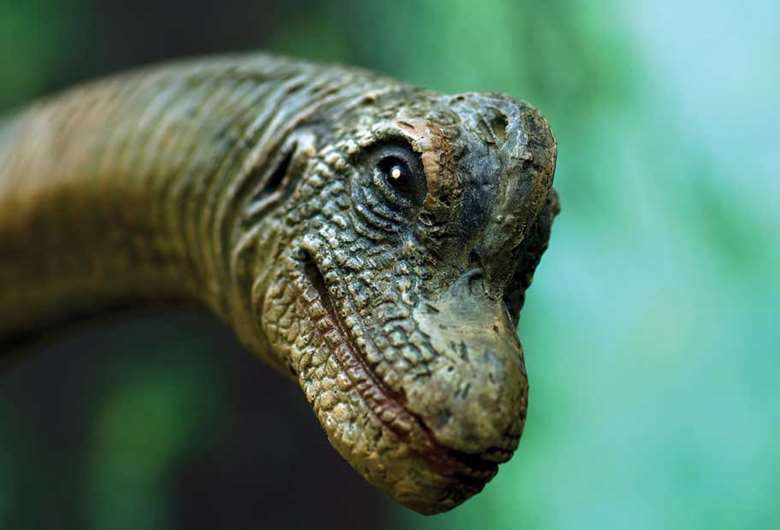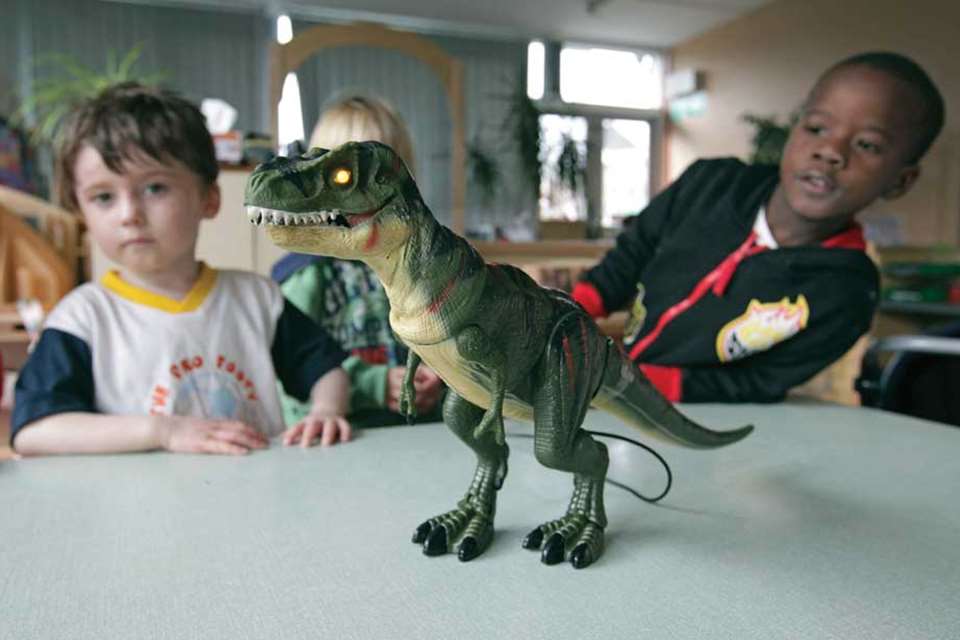Enabling Environments: Enhanced Provision - Dig in
Ruth Thomson
Monday, January 26, 2015
A dinosaur theme can enhance imaginative play and teach about change over time.

Children are endlessly fascinated by dinosaurs, so the enthusiasm of a few can quickly spread to all the others in a setting. Here are some activity ideas that give children a real insight into how the world of the dinosaurs has been uncovered and explored.
PALAEONTOLOGICAL DIG
Set up your own outdoor role-play palaeontological dig.
- Put up a tent. Provide sleeping bags, torches, pots, pans, camping kettle and mugs.
- Set out some shallow trays filled with damp sand. Press dinosaur bones, skeletons and fossils into the sand. Cover the bones and fossils with a layer of dry sand.
- Provide sieves, small brushes, clay sculpting tools, toy hammers and chisels for excavation.
- Provide zip-lock plastic bags, sticky labels, pens, rulers, notepads and child-friendly digital cameras for examining the finds.
- Draw a large map of the area showing where all the trays and the tent are situated. Display the map on an easel and provide pens for the children to mark where they find bones, skeletons and fossils.
Adult role
Join the play and model how to carefully excavate the dinosaur remains and fossils. Talk about the skeletons that the children find. Measure the bones, look at the skeleton shapes and use books to find out which dinosaur they may have come from.
Help the children to write the names of the dinosaurs on sticky labels and bag up their finds. Encourage them to take photos of the dig and create a display inside. Mount the photos of dinosaur skeletons next to pictures of dinosaurs in the flesh.
HAND-MADE FOSSILS
Use plaster of Paris and clay to make your own fossils.
- Show the children a selection of real fossils. Encourage them to examine and describe the patterns and marks.
- Use information books to find out which creatures created the different fossils.
- Give each child a lump of self-hardening clay with some sculpting tools. Encourage them to mould the clay and use the tools to carve patterns and markings. Leave the clay to dry and harden.
- Line dinosaur silicone moulds with petroleum jelly. Fill them with art roc or plaster of Paris. Leave them to dry and remove the moulds to reveal hand-made dinosaur fossils.
- Bury the fossils in the sand outside for excavation.
Plaster of Paris can also be used to make dinosaur footprints. Leave these lying around outside to enhance imaginative play.
FIND OUT MORE
Help the children use the internet to find out more about the creatures that they have unearthed.
- How big were the different dinosaurs?
- What did they eat - were they herbivores, carnivores or omnivores?
- How fast could they move?
- Did they live alone or in packs?
- Where did they live - on land or in the sea? And were any of them able to fly?
Child-friendly sites
Some child-friendly websites are:
- Andy's Dinosaur Adventures on the CBeebies website (www.bbc.co.uk/cbeebies/andys-dinosaur-adventures/watch). Find information and videos about some of the most well-known dinosaurs.
- Natural History Museum website (www.nhm.ac.uk/kids-only/dinosaurs). See the Dino Directory full of dinosaur facts, as well as 3D images that bring them to life.
Adult role
Encourage the children to think of their own questions. Is there something that they would really like to know about a particular dinosaur? If you can't find the answer on the internet, help the children use information books instead. Show them how to use the contents and index to help locate the information they are looking for inside the book.
WORKS OF ART
Provide craft materials for those children who are inspired to create dinosaur artworks. Fill the craft area with:
- junk, masking tape and green and brown poster paint for building model dinosaurs
- plasticine or playdough for moulding and sculpting models
- large toy dinosaurs for children to closely examine the different body shapes and features when making their own models
- pictures of dinosaurs that children can refer to when drawing and painting their own pictures
- giant polystyrene eggs that children can paint and use during imaginative play.
Resources
- Replica dinosaur skulls/fossils (www.yellow-door.net).
- Dino Dig Excavation Set with sieves, brushes and bones (www.earlyyearsresources.co.uk).
- Ancient fossils and dinosaur skeletons (www.cosydirect.com).
- A selection of dinosaur-themed silicone moulds for fossil-making (www.amazon.co.uk).
- Active World Dinosaur Mat and Small World Dinosaurs (www.tts-group.co.uk).
- Dinosaur Bones Match and Measure Set (www.yellow-door.net).
- Planning for Learning Through Dinosaurs by Marianne Sargent (Practical Pre-School Books).
Learning opportunities
PSED: Is confident to try new activities and chooses the resources needed for chosen activities.
CL: Uses language to imagine and recreate roles and experiences in play situations.
PD: Handles tools, objects and malleable materials safely and with increasing control.
L: Knows information can be retrieved from books and computers.
M: Begins to categorise objects according to properties such as shape and size.
UW: Develops an understanding of growth, decay and changes over time.
EAD: Explores a variety of materials, tools and techniques.
CASE STUDY - 'WE'RE PALAEONTOLOGISTS'

Watching and listening to the children in our care enables us to plan themes that build on their interests and motivate them to want to learn more. And in the case of one keyworker group of children at Happy Child Nurseries in London, that fascination was for dinosaurs.
Deputy manager, Satpal Saini, explains, 'It started because I've got a key child who's really crazy about dinosaurs. In fact, there are a few children in my group who really like them. We observed them talking about dinosaurs and thought we should do a project. We did some research and came up with the idea for the children to become palaeontologists,' he says.
The project began with a trip to the library, where the children chose information books about dinosaurs and used them to find out what they were and how they lived. The nursery staff followed this with discussion during circle time about the fate of the dinosaurs and what remains of them today.
'We explained what palaeontologists are, what they do and how they find dinosaurs,' Mr Saini explains. To help the children understand the job of a palaeontologist, nursery staff then set up an excavation site where the children could take on the role and have a go at uncovering some dinosaur remains themselves.
'We got a dinosaur skeleton sand mould that came in five pieces, buried it in our sand tray and covered it up,' says Mr Saini. The children learned about the care and patience needed when excavating an ancient site as they used paintbrushes to carefully clear the sand and reveal the dinosaur underneath.
The nursery staff decided to extend the experience by introducing frozen fossils that required the children to chip away at ice with wooden hammers.
'We got dinosaur toys, put them in balloons, filled them with water and put them in the freezer. Then we put the ice in the water tray and gave the children hammers to crack it open,' says Mr Saini. The children enjoyed emulating the experience of palaeontologists breaking through rock to reveal fossils buried deep inside. They then returned to the information books to find out about the dinosaurs they had discovered.
Extinction puts dinosaurs inside the realm of children's imaginations - they fascinate children and appeal to their sense of adventure and fantasy. However, their basis in reality also makes dinosaurs ideal for exploring the natural world. Setting up a role-play experience helps children to develop an understanding of death, decay and changes over time, including the difficult and abstract concept of fossilisation.
BOOK CORNER
 Monster Stones: the story of a dinosaur fossil
Monster Stones: the story of a dinosaur fossil
By Jacqui Bailey and Matthew Lilly
Illustrated story of a dinosaur's death and fossilisation.
 Fossil
Fossil
By Claire Ewart
In this picture book, a little girl finds a fossil and imagines what type of dinosaur it might have come from.
 Big Book of Big Dinosaurs
Big Book of Big Dinosaurs
By Alex Frith and Fabiano Fiorin
Illustrated information book with large colourful open-out pages. Part of a dinosaur series.
 Dinosaurs
Dinosaurs
By Stephanie Turnbull
Information book with accessible vocabulary and weblinks.
 Dinosaurs Love Underpants
Dinosaurs Love Underpants
By Claire Freedman and Ben Cort
Humorous alternative theory about how dinosaurs became extinct: it was a 'pants war'.
 Gigantosaurus
Gigantosaurus
By Jonny Duddle
Bonehead finds out what happens to little dinosaurs that cry wolf.
 The Dinosaur that Pooped the Past
The Dinosaur that Pooped the Past
By Tom Fletcher, Dougie Poynter and Garry Parsons
The dinosaurs take a trip back in time and are faced by an imminent volcanic eruption.
 Dinosaurs Galore!
Dinosaurs Galore!
By Giles Andreae and David Wojtowycz
Classic picture book with bright images and rhythmical rhyming text.
Marianne Sargent is a writer specialising in early years education and a former foundation stage teacher and primary and early years lecturer.





